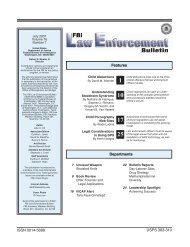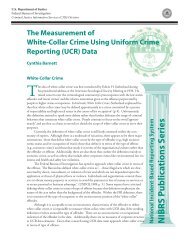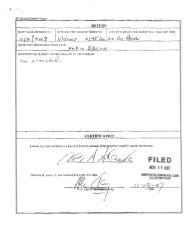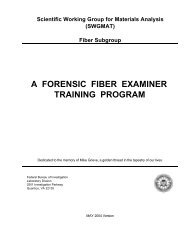F B I Law Enforcement Bulletin - June 2003 Issue
F B I Law Enforcement Bulletin - June 2003 Issue
F B I Law Enforcement Bulletin - June 2003 Issue
You also want an ePaper? Increase the reach of your titles
YUMPU automatically turns print PDFs into web optimized ePapers that Google loves.
themselves from the mainstream inmate population.<br />
This explains why STGs are a magnet for career<br />
criminals.<br />
Corrections practitioners who have identified<br />
STGs within their systems know that the groups’<br />
criminal activities extend beyond prison walls. Their<br />
success inside a corrections facility largely depends<br />
on an infrastructure on the outside to further their<br />
criminal enterprises, providing financial assistance<br />
and communication (i.e., intelligence). The overriding<br />
trait of these like-minded career criminals who<br />
comprise these groups is commitment. Upon release<br />
from prison, most of these offenders<br />
will continue to prey upon the<br />
community or those who dare to<br />
oppose them.<br />
Recognizing Prison Gangs<br />
Criminal gangs may participate<br />
in a wide range of illegal<br />
activities. Profits from unlawful<br />
actions, like drug dealing, can<br />
prove important to the cohesion of<br />
a street gang. To realize the<br />
desired profits, small, disorganized<br />
groups need a reliable drug<br />
source or a buyer for large<br />
amounts of stolen property.<br />
Bigger criminal enterprises, such<br />
as prison gangs, may provide the resources sought<br />
by a street crew. Managing the source of the illegal<br />
profits allows the larger gang to exert influence over<br />
street-level operations. Control is further strengthened<br />
when the upper-tier gang pays a street-level crew to<br />
perform tasks, such as assault or murder. As the<br />
connection between the groups solidifies, reputation<br />
and rumor can make a prison gang even more powerful,<br />
drawing other street-level crews into their sphere<br />
of influence.<br />
A hierarchy exists in the criminal gang world. 6<br />
Gangsters typically start out in a street crew, usually<br />
in a neighborhood or crowd where they have connections.<br />
These associations often will be rooted in<br />
family ties or friendship because gangs need both to<br />
trust partners in their criminal enterprises and to<br />
fraternize with during their social functions. At some<br />
point in their lives, criminal gang members eventually<br />
10 / FBI <strong>Law</strong> <strong>Enforcement</strong> <strong>Bulletin</strong><br />
may be incarcerated in a local jail and then in a<br />
longer-term state or federal facility. If they have a<br />
reputation among their peers that indicates their<br />
desirability as a candidate for induction into an STG,<br />
members inside the facility will approach them.<br />
Inmates may remain an associate of an STG or may<br />
earn a chance to become a full member. Either way,<br />
they will fulfill assignments given to them by the<br />
prison gang.<br />
The motivation driving the prison gang member is<br />
complex. While many sources have cited the need for<br />
protection from predatory inmates, other factors enter<br />
© brandXpictures<br />
in, including the human need to<br />
seek acceptance, increased status,<br />
and financial profit from gang<br />
activities. When gang members<br />
are released from custody, they<br />
often return to their neighborhoods<br />
and renew old associations.<br />
They then may reenter the gang<br />
subculture, which led to their<br />
incarceration. If they return to<br />
criminal activity, the contacts<br />
made in the prison system will<br />
become more important. The<br />
prison gang will allow the gangster<br />
on the outside to network<br />
with other criminals or provide<br />
regular secure sources for illegal<br />
products, such as drugs. The STG also will serve as<br />
protection for others in the gangster’s crew when they<br />
are incarcerated. The STG even may provide income<br />
to the street gang with compensation for missions it<br />
assigns.<br />
Because other street gangs will have similar<br />
situations, the prison gang can use the same methods<br />
to gain influence over a multitude of street crews.<br />
STGs will pick which sets they hope to influence and<br />
build a coalition. To control the street, a prison gang<br />
may withhold the desired product from an uncooperative<br />
set while ensuring that a competitor gets ample<br />
amounts. A more direct approach might occur,<br />
whereby an incarcerated member of an uncooperative<br />
gang may suffer an assault orchestrated by the STG.<br />
Or, a powerful group may order a cooperative street<br />
gang to use violence to force a reluctant clique to<br />
conform to the rules as formulated by the STG. In














